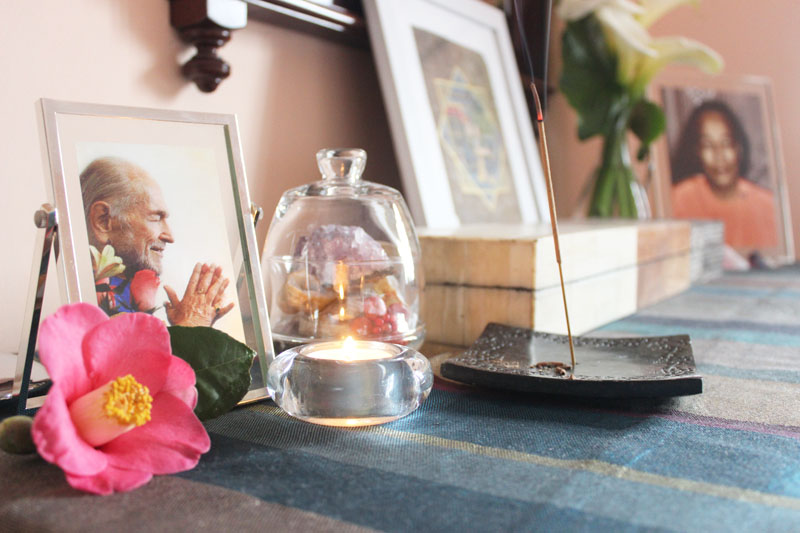How to create a good altar with Vastu Shastra
According to the American yogi Swami Kriyananda, your true altar is your own consciousness. However, having a symbol outside you like an altar, symbolizes a great help to reconnect with that aspect of your Self. That’s why I decided to write this post about how to create a good altar, using Vastu Shastra and yogic principles.
A good altar invites you to enter a sacred space where you can recharge, meditate, think, disconnect from problems, find inner peace and, above all, reconnect with your true essence.
Here I wanted to mention the most important requirements that I recommend you to create a good altar in your home or office.

How to create a good altar to pray or meditate?
The most important thing is the consciousness you put while creating it, such as the love and care put into it. Although you may not see it, how you do it, matters. And, it will carry that vibration!
I also recommend you to choose only materials, objects and images that are meaningful to you, boosted with good vibes.
There are many tips to create a good altar and, in this post, I’ll explain 7 practical requirements that you must take into account. Ready?
They are as follows:
1. Northeast corner is the best location inside your home or workspace
According to the Vastu Purusha Mandala guidelines, the Northeast corner is the best location in any space to have an altar, a yoga room or meditation space. Specially if you are in the Northern Hemisphere.
In India they call it “puja room” or “mandir”. Many people place it in the kitchen but this is more related to practical reasons. Each case is a whole world and the best location may vary depending on the characteristics of the space you have.
2. Place it towards North or East direction
The wall where you place it must be oriented towards North or East direction. So, it will make you face that direction every time you sit in front of it to pray or meditate.
Almost all temples and churches are oriented towards North or East directions. Have you ever noticed it? There are several reasons for that!
For example, in Christianity the East is related to the rising sun and the second coming of Christ.
According to Vastu Shastra and the science of Yoga, there are certain magnetic currents that flow from East to West, due to the Earth’s rotation.
Therefore, if you sit facing East, you will receive the benefits of these currents. According to great yogis, facing East helps to achieve enlightenment and North, liberation.
And now, you may be wondering: Which direction is the best? East or North?
Well, according to the science of yoga, it’s better to look East because one must attain enlightenment before freeing himself from all his karma. However, you also need to use your common sense considering the characteristics of the space you have.
3. Place it at a medium height, never at ground level
An altar should always be placed on a high level. On the physical plane, it’s like a mirror of your inner Self with the function of elevating you to higher states of consciousness. Thus, it must never be placed at ground level. (It’s pure logic …)
I would say that the ideal height should always be above the navel, especially when you sit in front of him to pray, pray or meditate.
In addition, I’d recommend covering it with a silk cloth to neutralize the possible negative influence of vertical magnetic currents, coming from the subsoil.
4. Use the 5 basic elements: water, air, fire, earth and ether
For a good energy to flow in the space, Vastu Shastra recommends harmonizing the 5 basic elements (Panchabutas or Pancha Maha Bhuta): water, air, fire, earth and ether. In ayurveda, it’s considered that the human body is formed of those 5 basic elements and must also be in harmony for the pranic energy to flow properly.
So, for your altar, I also recommend using these elements at the same time to activate the energy, bring dynamism to your practice and stimulate these elements already present inside you:
- Water: a cup with water or vase of water with flowers
- Air: incense or essence burner
- Fire: candles or oil lamps, always in odd numbers.
- Earth: gems and quartz that are in harmony with your energy.
- Ether: the vertical surface above the altar must have enough empty space for energy to flow. For example, don’t place an altar under a staircase or a beam.
5. Use harmonic colors
An altar should spread beauty, peace and well-being so I recommend avoiding the use and combination of strident colors. From the point of view of chromo therapy, there are very powerful colors that can give us certain qualities.
Here are some examples:
- white symbolizes purity and brings peace,
- green is a healing color that brings well-being,
- blue has a calming and expansive effect on the mind,
- the indigo and violet are excellent for fostering inspiration and spiritual work …
Normally, we are attracted to those colors whose quality we most need so… follow your instinct when choosing them!
6. Place only figures and images that inspire you
Placing photographs of great Masters or Saints help you to tune your conscience with theirs. I recommend that you place only those that have a special meaning to you.
An altar is not a bazaar to accumulate spiritual souvenirs. The accumulation of things will disperse your energy, instead of concentrating it.
Use the figures and images that you place as points of concentration and inspiration, as doors to the quality or dimension that you wish to develop in yourself.
Change them from time to time, depending on the occasion, holiday or purpose of your spiritual work so the energy won’t become stagnant.
7. Treat it as a sacred place, with order and cleanliness
Order transmit visual harmony and balance. This is a key factor if you want to achieve peace of mind every time you sit in front of the altar to pray or meditate.
Cleaning is also a very important factor for the altar to spark “good vibes”. According to the teachings of Patanjali, the awareness of freedom arises in the body and mind with perfect cleansing. So, the altar should also reflect this concept!
I also would invite you to do an active meditation every time you clean it. You can practice japa, chant mantras, pray or imagine that you are cleaning your entire being of impurities.
The awareness you put on the altar is important, treat it as a sacred space!
I think this is all I had to share with you today regarding how to create a good altar. If you have any questions, please feel free to ask anything you want in the comments bellow.
And, thank you for sharing it with all those who may be interested!
Sending you lots light from the altar of my soul,
Julia
*Photos: Julia de Dalalba

